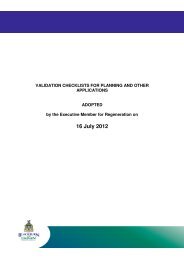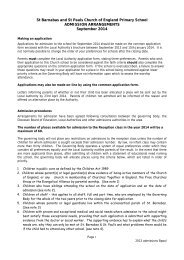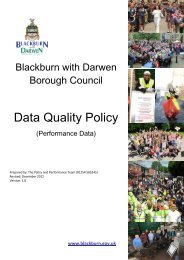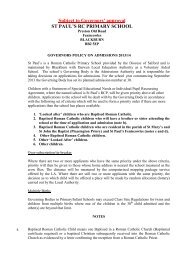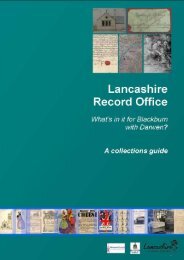Statement of Accounts 2011/2012 - Blackburn with Darwen Borough ...
Statement of Accounts 2011/2012 - Blackburn with Darwen Borough ...
Statement of Accounts 2011/2012 - Blackburn with Darwen Borough ...
You also want an ePaper? Increase the reach of your titles
YUMPU automatically turns print PDFs into web optimized ePapers that Google loves.
Depreciation is calculated on the following bases:<br />
NOTES TO THE FINANCIAL STATEMENTS<br />
• buildings - straight line allocation over the useful life <strong>of</strong> the property (1-50 years) as estimated by the valuer.<br />
• vehicles, plant, furniture and equipment – straight line allocation over 1-20 years, as advised by a suitably<br />
qualified <strong>of</strong>ficer.<br />
• infrastructure – straight line allocation over 2-40 years<br />
The standard approach is that newly acquired assets are not depreciated in the year <strong>of</strong> acquisition, and assets in<br />
the course <strong>of</strong> construction are not depreciated until they are brought into use. An exception to this is in respect <strong>of</strong><br />
vehicles purchased outright when this represents better value for money than leasing. Depreciation is also<br />
charged on PFI schemes in the year the asset is recognised on the balance sheet, in order to be consistent <strong>with</strong><br />
the Minimum Revenue Provision (MRP) calculation. In these cases a full year’s depreciation is charged in the<br />
initial year.<br />
Where an item <strong>of</strong> Property, Plant and Equipment asset has major components whose cost is significant in relation<br />
to the total cost <strong>of</strong> the item, the components are depreciated separately.<br />
Revaluation gains are also depreciated, <strong>with</strong> an amount equal to the difference between current value<br />
depreciation charged on assets and the depreciation that would have been charged based on their historical cost<br />
being transferred each year from the Revaluation Reserve to the Capital Adjustment Account.<br />
Disposals and Non-current Assets Held for Sale<br />
When it becomes probable that the carrying amount <strong>of</strong> an asset will be recovered principally through a sale<br />
transaction rather than through its continuing use (i.e. it is being “actively marketed”), it is reclassified as an Asset<br />
Held for Sale. The asset is revalued immediately before reclassification and then carried at the lower <strong>of</strong> this<br />
amount and fair value less costs to sell. Where there is a subsequent decrease to fair value less costs to sell, the<br />
loss is posted to the Other Operating Expenditure line <strong>of</strong> the Comprehensive Income and Expenditure <strong>Statement</strong>.<br />
Gains in fair value are recognised only up to the amount <strong>of</strong> any previous losses recognised in the Surplus or<br />
Deficit on Provision <strong>of</strong> Services. Depreciation is not charged on Assets Held for Sale.<br />
If assets no longer meet the criteria to be classified as Assets Held for Sale, they are reclassified back to noncurrent<br />
assets and valued at the lower <strong>of</strong> their carrying amount before they were classified as held for sale;<br />
adjusted for depreciation, amortisation or revaluations that would have been recognised had they not been<br />
classified as Assets Held for Sale; and their recoverable amount at the date <strong>of</strong> the decision not to sell.<br />
Assets that are to be abandoned or scrapped are not reclassified as Assets Held for Sale.<br />
When an asset is disposed <strong>of</strong> or decommissioned, the carrying amount <strong>of</strong> the asset in the Balance Sheet<br />
(whether Property, Plant and Equipment or Assets Held for Sale) is written <strong>of</strong>f to the Other Operating Expenditure<br />
line <strong>of</strong> the Comprehensive Income and Expenditure <strong>Statement</strong> as part <strong>of</strong> the gain or loss on disposal. Receipts<br />
from disposals (if any) are credited to the same line in the Comprehensive Income and Expenditure <strong>Statement</strong><br />
also as part <strong>of</strong> the gain or loss on disposal (i.e. netted <strong>of</strong>f against the carrying value <strong>of</strong> the asset at the time <strong>of</strong><br />
disposal). Any revaluation gains accumulated for the asset in the Revaluation Reserve are transferred to the<br />
Capital Adjustment Account.<br />
Amounts received for disposal in excess <strong>of</strong> £10,000 are categorised as capital receipts. A proportion <strong>of</strong> receipts<br />
relating to former housing disposals (75% for land and other assets, net <strong>of</strong> statutory deductions and allowances)<br />
is payable to the Government. The balance <strong>of</strong> receipts is required to be credited to the Usable Capital Receipts<br />
Reserve, and can then only be used for new capital investment or set aside to reduce the Council’s underlying<br />
need to borrow (the capital financing requirement). Receipts are appropriated to the Usable Capital Receipts<br />
Reserve from the <strong>Statement</strong> <strong>of</strong> Movement on the General Fund Balance.<br />
The written-<strong>of</strong>f value <strong>of</strong> disposals is not a charge against council tax, as the cost <strong>of</strong> fixed assets is fully provided<br />
for under separate arrangements for capital financing. Amounts are appropriated to the Capital Adjustment<br />
Account from the <strong>Statement</strong> <strong>of</strong> Movement on the General Fund Balance.<br />
s) Private Finance Initiative (PFI) and similar contracts<br />
PFI and similar contracts are agreements to receive services, where the responsibility for making available the<br />
property, plant and equipment needed to provide the services passes to the PFI contractor. As the Council is<br />
deemed to control the services that are provided under its PFI schemes, and as ownership <strong>of</strong> the property, plant<br />
and equipment will pass to the Council at the end <strong>of</strong> the contracts for no additional charge, the Council carries the<br />
assets used under the contracts in its Balance Sheet as part <strong>of</strong> Property, Plant and Equipment.<br />
The original recognition <strong>of</strong> these assets at fair value (based on the cost to purchase the property, plant and<br />
equipment) will be balanced by the recognition <strong>of</strong> a liability for amounts due to the scheme operator to pay for the<br />
capital investment.<br />
Non current assets recognised on the Balance Sheet will be revalued and depreciated in the same way as<br />
property, plant and equipment owned by the Council.<br />
<strong>2011</strong>/12 is the first year in which transactions in relation to PFI projects are included <strong>with</strong>in the accounting<br />
statements and the amounts payable to the PFI operators each year are analysed into five elements:<br />
- - 28 - -




